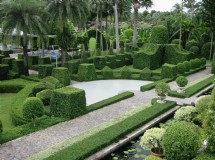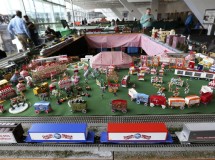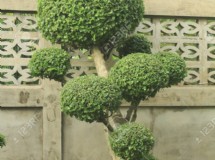A netsuke (net-skeh) is a miniature sculpture developed in Japan over a period of more than three hundred years. The kimono, the traditional form of Japanese dress, had no pockets. Men suspended pouches (inro) on a silk cord from their sash (obi) . To stop the cord from slipping through the "obi", a small toggle is attached. That small toggle is the "netsuke".
Dutchman
The netsuke referred to in the headline of this article was auctioned at the German auctionhouse Lempertz on 27 November 2004. It was estimated at $60.000,- (Euro 40.000) but was hammered at a sensational US$230.000,- (Euro 154.000). This unusually large (H 5 2/5") ivory netsuke of a standing Dutchman holding a dead hare over his shoulder which is attached to a gun, dated late 18th Century, stands out by two characteristics: the somewhat caricature-like facial features and elegant dress, as well as his occupation as a hunter whose bait is an indication of the "South Barbarian meat eaters".
Why US$230.000,-?
The exraordinary hammer price of US$230.000,- for this specific piece can be explained by looking at its history, theme, craftmanship, condition and off course by its rarity. The object made its way over 100 years in famous netsuke collections, and was already publicized in 1895 by the Japonist art dealer Marcus B. Huish. The representation of the Westerner, especially that of the Dutchman in Japanese art (in woodblock prints and netsuke) is a much coveted subject. This because of the striking depiction by the Japanese artists of this "strange" people from another world giving the beholder a very insightful and comic explanation of the encounter of two very different cultures. The unknown creator, it is unsigned, of this particular netsuke had to be a masterful craftsman because of his magnificent eye for detail and its elegant look. The specific subject of the Dutchman is not uncommon but a quality piece in this condition in combination with its age is a very rare find.
More examples
During the last decades there are more examples of highlights in prices concerning netsukes. On May 1990 at auctionhouse Sotheby's in London a netsuke of a horse was hammered at US$260,000,- and through an anitques dealer at Oriental Treasures and Points West in Honolulu a netsuke representing a "Awabi Girl and Octopus" (like Hokusai's famous "Dream of Fisherman's Wife (Octopus)" shunga design!) was sold at approx. US$250,000.
Themes
Netsuke carvers mostly worked in a bounded area of subjects and themes such as scenes of daily life, animals, erotic encounters (shunga), the signs of the zodiac or subjects with a mythical background. Whatever its subject or theme netsuke is a very attractive and highly collectable art form and the interesting pieces will only continue to increase in value.
Books
One of the most referred books among netsuke collectors are Lazarnick's ' The Signature Book of Netsuke' and from the same author 'Netsuke & Inro Artists, and How to Read Their Signatures'. Both have been issued in limited editions, the first one in 500 copies and the latter in 876 copies. These books are unmissable for the serious netsuke collector. More recommended books on netsuke are 'Netsuke: The Tokyo Meiko Kagami , Tokyo Living Masters List' by Shingo Yamaguchi, 'Netsuke: Fantasy and Reality in Japanese Miniature Sculpture' by Joe Earle and 'Expressions of Style: Netsuke as Art' by Rosemary Bandini.
Netsuke Organisations
International Netsuke Society
International Netsuke Carvers' Association
Dutchman
The netsuke referred to in the headline of this article was auctioned at the German auctionhouse Lempertz on 27 November 2004. It was estimated at $60.000,- (Euro 40.000) but was hammered at a sensational US$230.000,- (Euro 154.000). This unusually large (H 5 2/5") ivory netsuke of a standing Dutchman holding a dead hare over his shoulder which is attached to a gun, dated late 18th Century, stands out by two characteristics: the somewhat caricature-like facial features and elegant dress, as well as his occupation as a hunter whose bait is an indication of the "South Barbarian meat eaters".
Why US$230.000,-?
The exraordinary hammer price of US$230.000,- for this specific piece can be explained by looking at its history, theme, craftmanship, condition and off course by its rarity. The object made its way over 100 years in famous netsuke collections, and was already publicized in 1895 by the Japonist art dealer Marcus B. Huish. The representation of the Westerner, especially that of the Dutchman in Japanese art (in woodblock prints and netsuke) is a much coveted subject. This because of the striking depiction by the Japanese artists of this "strange" people from another world giving the beholder a very insightful and comic explanation of the encounter of two very different cultures. The unknown creator, it is unsigned, of this particular netsuke had to be a masterful craftsman because of his magnificent eye for detail and its elegant look. The specific subject of the Dutchman is not uncommon but a quality piece in this condition in combination with its age is a very rare find.
More examples
During the last decades there are more examples of highlights in prices concerning netsukes. On May 1990 at auctionhouse Sotheby's in London a netsuke of a horse was hammered at US$260,000,- and through an anitques dealer at Oriental Treasures and Points West in Honolulu a netsuke representing a "Awabi Girl and Octopus" (like Hokusai's famous "Dream of Fisherman's Wife (Octopus)" shunga design!) was sold at approx. US$250,000.
Themes
Netsuke carvers mostly worked in a bounded area of subjects and themes such as scenes of daily life, animals, erotic encounters (shunga), the signs of the zodiac or subjects with a mythical background. Whatever its subject or theme netsuke is a very attractive and highly collectable art form and the interesting pieces will only continue to increase in value.
Books
One of the most referred books among netsuke collectors are Lazarnick's ' The Signature Book of Netsuke' and from the same author 'Netsuke & Inro Artists, and How to Read Their Signatures'. Both have been issued in limited editions, the first one in 500 copies and the latter in 876 copies. These books are unmissable for the serious netsuke collector. More recommended books on netsuke are 'Netsuke: The Tokyo Meiko Kagami , Tokyo Living Masters List' by Shingo Yamaguchi, 'Netsuke: Fantasy and Reality in Japanese Miniature Sculpture' by Joe Earle and 'Expressions of Style: Netsuke as Art' by Rosemary Bandini.
Netsuke Organisations
International Netsuke Society
International Netsuke Carvers' Association
SHARE






































